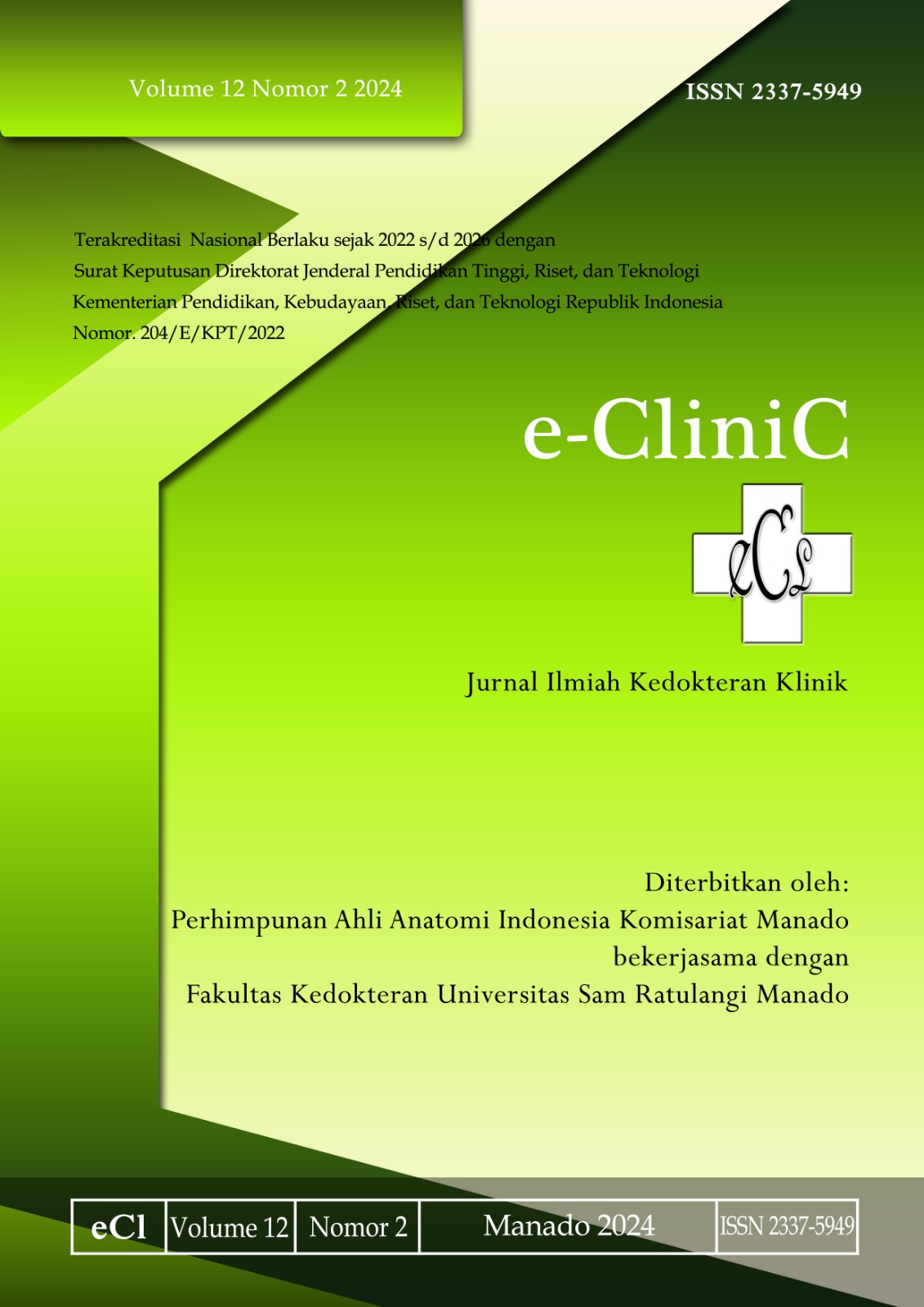Keakuratan FNAB pada Limfadenitis Tuberkulosis di Kelenjar Getah Bening Leher di Manado
DOI:
https://doi.org/10.35790/ecl.v12i2.46849Abstract
Abstract: Tuberculous lymphadenitis is the most common type of extrapulmonary tuberculosis (TB). Fine needle biopsy aspiration (FNAB) is an initial diagnostic method to evaluate lymph node enlargement in the neck This study aimed to evaluate the accuracy of FNAB in tuberculous lymphadenitis in neck lymph nodes in Manado. This was is a retrospective and descriptive study using medical record data on the use of FNAB examination in patient with a history of lymph node enlargement years 2017-2018. The results obtained 160 FNAB samples with clinical lymph node enlargement in the neck; 86 samples (54%) with TB lymphadenitis, nine samples (6%) were suspected as TB lymphadenitis, and 65 samples (40%) were not TB lymphadenitis The incidence in women (61%) was higher than in men (39%). TB lymphadenitis was most common in women aged <19 years and men aged 20-30 years. In conclusion, FNAB remains an important option as one of the diagnostic supporting tools for lymph node enlargement especially to confirm the diagnosis of tuberculous lymphadenitis in the neck.
Keywords: fine needle biopsy aspiration; tuberculous lymphadenitis; cytopathological diagnosis
Abstrak: Limfadenitis tuberkulosis (TB) merupakan bentuk TB ekstrapulmoner yang tersering. Fine needle biopsy aspiration (FNAB) ialah metode diagnostik awal untuk mengevaluasi pembesaran kelenjar getah bening di leher. Penelitian ini bertujuan untuk mengetahui keakuratan FNAB pada limfadenitis tuberkulosis di kelenjar getah bening leher di Manado. Jenis penelitian ialah deskriptif retrospektif menggunakan data rekam medik penggunaan pemeriksaan FNAB pada pasien yang memiliki riwayat pembesaran kelenjar getah bening di leher di Laboratorium Patologi Anatomi RSUP Prof R. D. Kandou Manado.tahun 2017-2018. Hasil penelitian mendapatkan 160 sampel FNAB dengan klinis pembesaran pada leher; 86 sampel (54%) dengan hasil FNAB limfadenitis TB, sembilan sampel (6%) dicurigai sebagai limfadenitis TB, dan 65 sampel (40%) bukan limfadenitis TB. Kejadian pada perempuan (61%) lebih tinggi daripada laki-laki (39%). Limfadenitis TB tersering pada perempuan berusia <19 tahun dan laki-laki 20-30 tahun. Simpulan penelitian ini ialah sampai saat ini FNAB tetap menjadi pilihan sebagai salah satu alat penunjang diagnostik untuk evaluasi pembesaran kelenjar getah bening terutama dalam menentukan limfadenitis TB di leher.
Kata kunci: fine needle biopsy aspiration; limfadenitisis tuberculosis; diagnostik sitopatologi
References
World Health Organization (WHO). Global Tuberculosis Report 2017. [cited 2019 Feb 01]. Available from: www.who.int/tb
Laporan TB Indonesia 2015. [cited 2019 Feb 01]. Available from: www.tbindonesia.or.id
Sudoyo AW, Setyohadi B, Alwi I dkk. Buku Ajar Ilmu Penyakit Dalam. Jilid III Edisi V. Jakarta: Interna Publishing Pusat Penerbitan Ilmu Penyakit Dalam, 2009. p. 2230-38
Sjamsuhidajat R, Theddeus OH, Prasetyono RR. Buku Ajar Ilmu Bedah Jilid II (4th ed). Jakarta: EGC; 2017. p. 475.
Tatar D, Senol G, Alptekin S, Gunes E. Assessment of lymph node tuberculosis in two provinces in Turkey. J Infect Dis. 2011;64:316-21. Available from: https://pubmed.ncbi.nlm.nih.gov/21788708/
Pierce AG, Neil RB. Surgery at a Glance (3rd ed). USA: Wiley-Blackwell Publishing; 2013. p. 10-1.
Bayrak YB, Özkara SK. Fine needle aspiration of non-thyroidal head and neck masses: Correlation of the cyto-histo pathological diagnoses, causes of inconsistency and traps. Ann Diagn Pathol. 2019;39:15-20. Doi: 10.1016/j.anndiagpath.2018.12.004
Qasmi SA, Kiani, F, Malik AI, Salamatullah J. Farooq MO, Abassi MA. Cervical lymphadenopathy: a common diagnostic dilemma. J Int Surgery Pakistan. 2012;17(2):76- 80.
Arul P, Masilamani S, Akshatha S. Diagnostic efficacy of fine needle aspiration cytology in cervical lymphadenopathy. J Sci Soc (Belgaum). 2016;43(3):117-21. Doi: 10.4103/0974-5009.190519
Orell SR, Sterrett GF. Fine Needle Aspiration Cytology (5th ed). Philadelphia: Elsevier; 2012. p. 77-117.
Downloads
Published
How to Cite
Issue
Section
License
Copyright (c) 2024 Jessie I Ijong, Nico Lumintang

This work is licensed under a Creative Commons Attribution-NonCommercial 4.0 International License.
COPYRIGHT
Authors who publish with this journal agree to the following terms:
Authors hold their copyright and grant this journal the privilege of first publication, with the work simultaneously licensed under a Creative Commons Attribution License that permits others to impart the work with an acknowledgment of the work's origin and initial publication by this journal.
Authors can enter into separate or additional contractual arrangements for the non-exclusive distribution of the journal's published version of the work (for example, post it to an institutional repository or publish it in a book), with an acknowledgment of its underlying publication in this journal.
Authors are permitted and encouraged to post their work online (for example, in institutional repositories or on their website) as it can lead to productive exchanges, as well as earlier and greater citation of the published work (See The Effect of Open Access).







